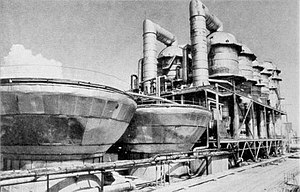BN-350 reactor
| Aktau nuclear power plant | |
|---|---|
 Past BN-350 desalination unit. | |
 | |
| Country | Kazakhstan |
| Location | Aktau |
| Coordinates | 43°36′25″N 51°16′59″E / 43.607°N 51.283°ECoordinates: 43°36′25″N 51°16′59″E / 43.607°N 51.283°E |
| Status | Decommissioned |
| Construction began | 1964 |
| Commission date | 1973 |
| Decommission date |
|
| Operator(s) | |
| Nuclear power station | |
| Reactor type | sodium-cooled fast reactor (BN350) |
| Reactor supplier | Atomenergoproekt |
| Power generation | |
| Make and model | |
| Units decommissioned | 1 × 350 MW |
| Nameplate capacity |
|
| External links | |
| Website | maek |

The BN-350 was a sodium-cooled, fast reactor located at the Mangyshlak Nuclear Power Plant, located in Aktau (formerly known as Shevchenko in 1964–1992), Kazakhstan, on the shore of the Caspian Sea.
Construction of the BN-350 fast breeder reactor began in 1964, and the plant first produced electricity in 1973. In addition to providing power for the city (350 MWe), BN-350 was also used for producing plutonium and for desalination to supply fresh water (120,000 m³ fresh water/day) to the city.[1]
Closure and decommissioning[]
The project lifetime of the reactor officially finished in 1993, and in June 1994, the reactor was forced to shut down because of a lack of funds to buy fuel. By 1995, the plant's operating license had expired. The facility continued to operate far below capacity until reactor operations ceased in 1999, when plutonium-bearing spent fuel stopped being produced.
Disposition of spent fuel was executed with technical and financial assistance of the US government.[2] Some 3000 cubic metres of liquid radioactive waste, mainly sodium and caesium-137 with a half-life of 30 years, are stored at MAEK-Kazatomprom. Short-term safe storage will be 10 years, followed by a long-term dry storage of 50 years.[3] Total decommissioning cost was estimated in 2020 at $ 330 million to be paid by local residents through the electricity tariff. [3]
See also[]
- BN-reactor
- BN-600 reactor
- BN-800 reactor – Russian Fast breeder nuclear reactor, operating since 2016
- BN-1200 reactor – Fast breeder nuclear reactor under development in Russia
References[]
- ^ The BN-350 decommissioning project. IAEA, 2002 (Record 34060088)
- ^ Criticality Safety Issues in the Disposition of BN-350 Spent Fuel. Argonne National Laboratory, 28 Feb 2000. Abstract
- ^ a b Local residents pay for decommissioning of Kazakhstan’s BN-350 reactor, NEI, 27 Feb 2020
- Nuclear technology in the Soviet Union
- Soviet inventions
- Liquid metal fast reactors
- Nuclear power stations built in the Soviet Union
- Nuclear power stations in Kazakhstan
- Former nuclear power stations
- Former power stations in Kazakhstan
